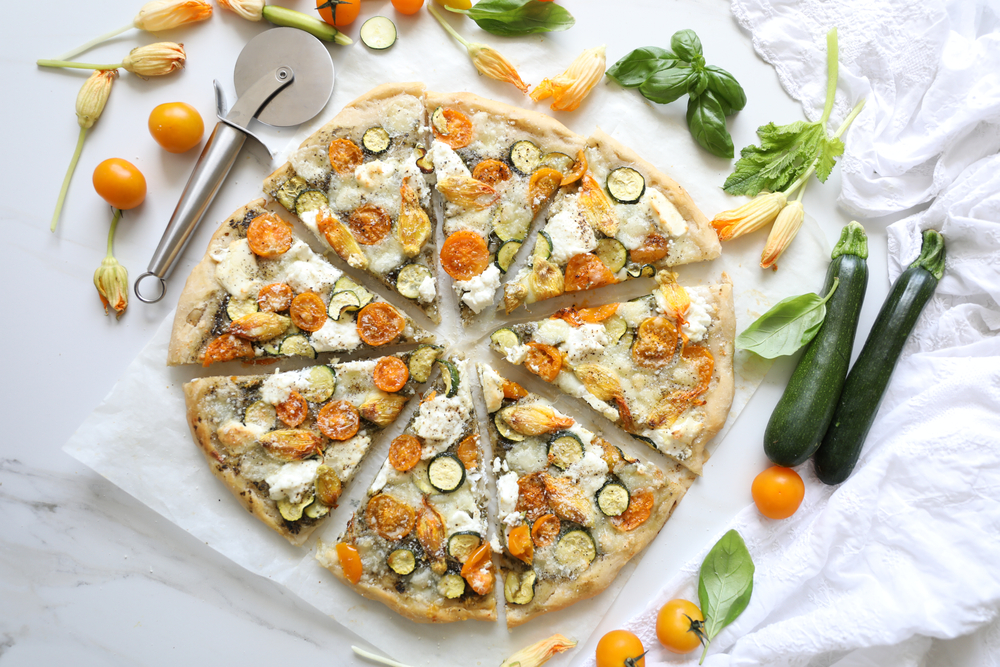
Make Your Own Pizza – So Simple. Really.
From your email, please click on the title to view the photos and comment online. On the Website, you can read past blogs, search for recipes, and browse.
How many pizzas have you eaten in your lifetime? And what did they look like? Since I first began consuming pizza pies in earnest some 50 years ago, the dish has clearly transformed. Given the history of pizza in the U.S., we sort of grew up together. Now, we make our own pizzas at home, which is surprisingly quick and easy and allows for individual tastes and variety. It’s easy enough to do what the pizzerias do and put more cheese and sausage on one half and hold the onions on the other, for example, as customers request.
Although pizzas were first introduced in the U.S. by Italian immigrants early in the 20th century, pizzerias didn’t really gain ground until the 1930s. And it wasn’t until after World War II, when returning GIs who’d served in Italy brought back a hunger for the pies, that pizza caught fire in the U.S. That’s when one of those GIs, who had worked for his father repairing ovens, built the first gas-fired pizza oven, which allowed retailers to bake pizzas quickly and efficiently at high temperatures. When those became available, pizzerias owned by independent operators began sprouting up around the country, usually beginning as taverns. And it wasn’t until 1958 when Pizza Hut was incorporated in Wichita, Kansas.
That explains why I wasn’t exposed to pizza growing up. Our local community was mostly
Scandinavian, with not a lot of Italian families. Of course, there was Chef Boyardee’s pizza kit. I experienced my own pizzapalooza one afternoon when my mother was away. My father and his pal Bob came home from the tavern with the munchies and wanted pizza, so I was drafted to make one from the Chef Boyardee kit employing the dough mix, canned sauce, and canned cheese. Unfortunately for me, one was not enough, so they drove into town to replenish supplies, and I ended up cracking open three more Chef Boyardee boxes. Five years later, I was in college where everyone was full in with pizzas since we could easily order a delivery in our dorms.
Regional variations
Meanwhile, as pizza spread across the country, various regions developed their own. New York uses a variation of the original Neapolitan pizza while Chicago developed a deep-dish style with a thick crust and ingredients in reverse, topping the dough with cheese followed by meat and vegetables and tomato sauce. Greek-style pizza with a thick, chewy crust, usually heavier on the sauce, is trendy in New England. Detroit-style pizza has a thick crust topped with pepperoni followed by brick cheese, then covered with tomato sauce. Down in St. Louis, pizza is a thin, crispy crust and a sweet sauce with Provel cheese, a combination of cheddar, Swiss, and provolone. Restaurants have long been creative in their toppings. Somebody came up with the idea of a “Hawaiian” version with ham and pineapple, and of course, California pizza is known for its thin crust with all kinds of unusual ingredients. Any number of restaurants are offering a thin-crust pie topped with salad – not my idea of pizza.
Homemade variations
Here in Farmboy-land, we have all the tools to make our own: a standing mixer with a dough hook for the crust and a good pizza stone. The old meat, onion, and red sauce pizza topped with mozzarella is not the favorite here. The preferred style is a medium crust topped with pepperoni and chopped roasted red peppers, artichoke hearts, and olives, then sprinkled with grated parmesan cheese. After the dough rises, ten minutes in a 500-degree oven and it’s dinner time. Pizza stones are inexpensive and take up very little room in the kitchen cabinet. And there’s no reason to make your own dough as we do; just keep some in the freezer, store-bought or homemade ahead of time.
What’s cooking in homes around the country? I myself have experimented with “pizzas” on English muffins and French bread. I’ve heard of folks trying to make taco pizza. But what about combining your favorite sandwich with pizza such as a cheeseburger pizza or a BLT, a Reuben, a chicken club, or a chili dog pizza? As for different meats, how about a shrimp and crab pizza, or one featuring Thai chicken, chicken Caesar, or a steak and blue cheese pizza? For a vegetarians, how about an arugula and mushroom pizza, baked potato pizza, or a simple hummus pizza? There are lots of people who like leftover pizza for breakfast. So how about making a breakfast pizza? Sausage and mushrooms? Or a shakshuka pizza?
After all, America’s favorite comfort food is bound to be tweaked to match the tastes and desires of the household. What’s yours?
Please click on the headline to view the blog on the website. You can log in and comment at the end of the blog to share your thoughts and start a discussion, or suggest a topic for Farmboy in the Kitchen.
If you’d like to share the blog, click on the Facebook icon or one of the others. Thanks!





2 Comments
Tracy May
Farmboy, you’re making me hungry! Especially when I think of one of the best pizzas I ever had while on a ski vacation in Vail – a soppressata and arugula pizza with mozzarella, fontina and a tiny bit of honey drizzled on top. It probably included other ingredients but that’s all I can remember. Wish I could find soppressata up here in the woods.
Farmboy
It must be genetic. Your sister, Mrs. Farmboy, loves a similar pizza at a restaurant we frequent in New York.